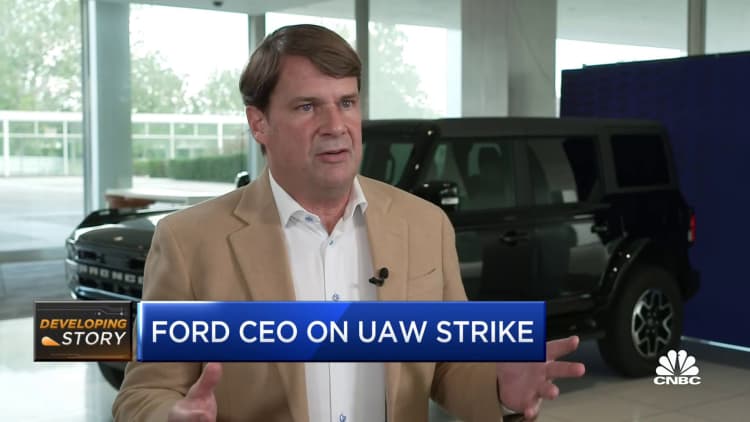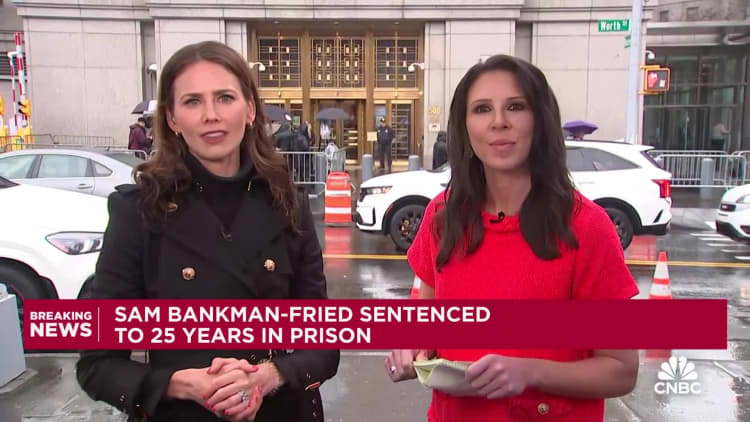Members of the United Auto Workers union hold a rally and practice picket near a Stellantis plant in Detroit, Aug. 23, 2023.
Michael Wayland / CNBC
DETROIT – Thousands of members of the United Auto Workers went on strike at three U.S. assembly plants of General Motors, Ford Motor and Stellantis, after the union and the automakers failed to reach a deal on a new labor contract Thursday night.
“The UAW Stand Up Strike begins at all three of the Big Three,” the union said in a post on X, the site formerly known as Twitter, just after midnight Friday.
The facilities are GM’s midsize truck and full-size van plant in Wentzville, Missouri; Ford’s Ranger midsize pickup and Bronco SUV plant in Wayne, Michigan; and Stellantis’ Jeep Wrangler and Gladiator plant in Toledo, Ohio. For Ford, UAW President Shawn Fain said only workers in paint and final assembly will be on strike.
“We got to do what we got to do to get our share of economic and social justice in this this strike,” Fain said outside the Ford facility in Wayne, minutes after the strike began. “We’re going to be out here until we get our share of economic justice. And it doesn’t matter how long it takes.”
The selected plants produce highly profitable vehicles for the automakers that largely continue to be in high-demand. About 12,700 workers – 5,800 at Stellantis, 3,600 at GM and 3,300 at Ford – will be on strike at the plants in total, the union said. The UAW represents about 146,000 workers across Ford, GM and Stellantis.
UAW President Shawn Fain, center, talks to reporters as union members strike outside a Ford plant in Wayne, Michigan, Sept. 15, 2023.
CNBC | Michael Wayland
“If they come to the pump and they take care of their workers, we’ll be back to work,” Fain said early Friday, referring to the automakers. “But if they don’t, we’ll keep amping it up.”
The union selected the plants as part of targeted strike plans initially announced Wednesday night by Fain, who has unconventionally been negotiating with all three automakers at once and has been reluctant to compromise much on the union’s demands.
Read more: General Motors sweetens its offer to include 20% wage increase
“For the first time in our history, we will strike all three of the ‘Big Three’ at once,” Fain said just after 10 p.m. Thursday in live remarks streamed on Facebook and YouTube. “We are using a new strategy, the ‘stand-up’ strike. We will call on select facilities, locals or units to stand up and go on strike.”
Fain has referred to the union’s plans as a “stand-up strike,” a nod to historic “sit-down” strikes by the UAW in the 1930s.
Key proposals from the union have included 40% hourly pay increases, a reduced 32-hour work week, a shift back to traditional pensions, the elimination of compensation tiers and a restoration of cost-of-living adjustments (COLA), among other items on the table including enhanced retiree benefits and enhanced vacation and family leave benefits.
By late Thursday, it was clear there wouldn’t be a deal, even as President Joe Biden got involved. The White House said Biden, who boasts of his blue collar background and support for organized labor, talked with Fain and the leaders of the Detroit automakers.
Ford, in a statement Thursday night, said the UAW presented its “first substantive counterproposal” to four of the company’s offers, but it “showed little movement from the union’s initial demands.”
“If implemented, the proposal would more than double Ford’s current UAW-related labor costs, which are already significantly higher than the labor costs of Tesla, Toyota and other foreign-owned automakers in the United States that utilize non-union-represented labor,” Ford said. “The union made clear that unless we agreed to its unsustainable terms, it plans a work stoppage at 11:59 p.m. eastern.”
The automakers have made record proposals that address some of the UAW’s ambitious demands but not all of them. Specifically, the companies have offered wage increases of roughly 20%, COLA, altered profit-sharing bonuses; and enhanced vacation and family leave enhancements that the union has found inadequate.
Targeted strikes typically focus on key plants that can then cause other plants to cease production due to a lack of parts. They are not unprecedented, but the way Fain plans to conduct the work stoppages is not typical. They include initiating targeted strikes at select plants and then potentially increasing the number of strikes based on the status of the negotiations. Selecting assembly plants for such strikes is also unique.

Credit: Source link















